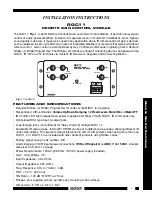
3 (6)
0-003-3263-2 (EN)
The actuator may be mounted
horizontally, vertically and in any position
in between, but
not
upside down, see
figure 3.
N.B.!
Do not use the actuator for the
DN15 valves V298, V282, V294, V384,
V386 and V394.
To mount the actuator on a valve, slide
the actuator onto the valve neck, thus
making the square nut on the valve spindle
fit into the groove on the cross bar. Then
slide the brace into the groove on the
valve neck and secure the nuts.
N.B.!
When coupling the spindle, register
it to get a small spring pre-load.
Figure 3
MOUNTING
CONNECTIONS
Block Function
Description
G
24 V AC
Supply
G0
24 V AC rtrn
voltage
X1
Input
Control sign-
MX
Input, neutral
als (VH, VC
VH
Increase
short-circuited
VC
Decrease
to G0)
G1
16 V DC
Supply for RC
Y
0–100 %
Feedback
signal
N.B.!
When installed with three
conductors, where the control signal
reference is connected to G0, the motor
current of the actuator will cause
varying voltage loss in the cable and
thus in the reference level. Forta, which
has a highly sensitive control signal
input, will detect the varying signal and
follow it, which makes it difficult for the
actuator to find a stable position.
This variation may be accepted in
simplified installations on the following
conditions: the cables between the
controller and actuator are shorter than
100 m (328 ft.), the cross-sectional area
is larger than 1.5 mm2 (AWG 16) and
the cables are only connected to
one
actuator. Please refer to the figures
labelled “Simplified installation” for
wiring instructions.
Cable lengths
The cables to G, G0 and G1 should be
max. 100 m (328 ft.) and have a cross-
sectional area of min. 1.5 mm²
(AWG 16).
Other cables should be max. 200 m
(656 ft.) and have a cross-sectional
area of min. 0.5 mm² (AWG 20).
Figure 5
Terminal
block
























